- First five ingredients: Deboned lamb, fish meal, oatmeal, brown rice, barley
- Type: Dry kibble
- Flavors: Lamb & Oatmeal, Chicken & Brown Rice
Best Dog Food for Puppies: Top Picks of 2024

Our evaluations and opinions are not influenced by our advertising relationships, but we may earn a commission from our partners’ links. This content is created by TIME Stamped, under TIME’s direction and produced in accordance with TIME’s editorial guidelines and overseen by TIME’s editorial staff. Learn more about it.
Since your puppy is a one-of-a-kind sweetheart, it’s up to you as a caring pet parent to find the best puppy food for their unique nutritional needs at this critical time in their development.
Puppies need a complete and balanced diet with quality protein, antioxidants, vitamins and minerals so they can grow up healthy and strong. But with so many flavors, sizes, diets, and types of food on the market, it can be difficult to select the optimum meal without doing some research beforehand. Each puppy is special, and because you may be shopping for a puppy with digestion problems, food allergies, or a picky attitude, we took the time to research, compare, and test multiple recipes to find the top 14 puppy foods available:

Unfortunately, many affordable puppy foods are nutritionally unimpressive and include worthless fillers and artificial colors, but with Blue Buffalo Life Protection, you won’t have to sacrifice your savings to provide a nourishing kibble for your puppy. Not only is this a fairly priced, yet high-end formula, Blue Buffalo features two different recipes with their exclusive LifeSource Bits™. These cold-formed kibbles are full of antioxidants, minerals, and vitamins to support overall health. The Lamb & Oatmeal formula is a grain-free alternative to the many puppy foods supplemented with rice, barley, and oatmeal.
Between its high nutritional content and grain-free formulas, Blue Buffalo proves that you can feed your puppy a proper diet without breaking the bank.
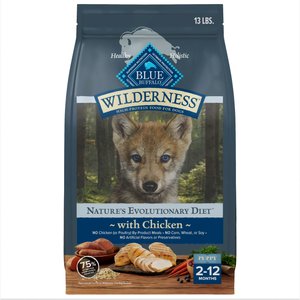
When it comes to Yorkshire terriers, silkie terriers, and other small breed puppies, the best dog food is nutritious and easy for their tiny mouths to chew, and this healthy, high-protein, and highly digestible kibble is an excellent choice. With its first three ingredients, little puppies are getting a large amount of quality poultry, while the rest of the recipe is full of healthy foods as well, such as oatmeal and barley for smooth digestion, fish meal and oil for skin and coat health, and nutrient-rich carrots, blueberries and sweet potatoes.
These little, yet nutrition-packed kibble pieces are an especially healthy option to get small breeds on a quality diet from the start.
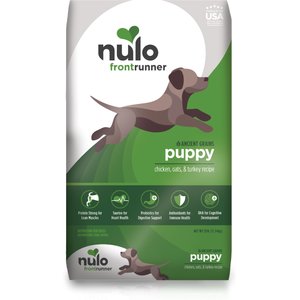
If you’re raising a Great Dane, husky, or other large breed, you’re going to need a nutrient-filled food that will support your puppy as they sprout up like a weed, and Nulo’s Frontrunner formula does exactly that. With 77% of this formula’s protein mainly sourced from chicken and turkey, it’s a top pick for big puppies who need the protein for developing lean muscles and a healthy heart. In addition to its health-promoting ingredients for brain, coat, and skin, Frontrunner’s small kibble size and hearty grains are optimized for easy digestion.
This extra-large kibble formula includes the additional animal protein, probiotics, and weight-management ingredients for puppies to grow up to be huge dogs.
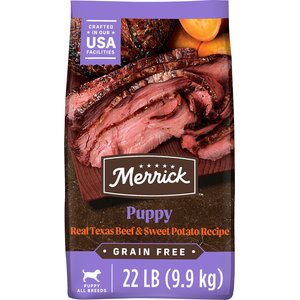
Its high-protein recipe, nutritious mix of wholesome ingredients like blueberries, potatoes, and apples, and pairing of flavors impressed me and my puppies enough to name Merrick Grain-Free Puppy the best dry dog food for your puppy. Merrick’s dry kibble sports a healthy mix of protein and produce, with approximately 70% of its protein from animal-based sources, is made without rice, oatmeal, and other grains, and its bite-sized pieces notably improve a puppy’s digestion for an all-around excellent dry food.
Its high animal protein content, nutritious collection of ingredients rich in fiber, minerals, and vitamins, makes this a top dry dog food for puppies.

Sometimes wet canned food is the best option for puppies because they generally include more protein than their dry counterparts, are especially easy to digest, and help to keep active puppies hydrated, but Nulo Freestyle’s notably high protein content, quality meaty ingredients, and an array of healthy ingredients like cod, turkey, and pumpkin makes this an especially attractive wet food. We also appreciate that Nulo Freestyle is available in two puppy-focused flavors, rich in essential vitamins and minerals, and is a grain-free recipe.
While puppies will beg for this palatable wet food, you will feel good treating your best friend with a protein-filled meal that only utilizes high-end ingredients.
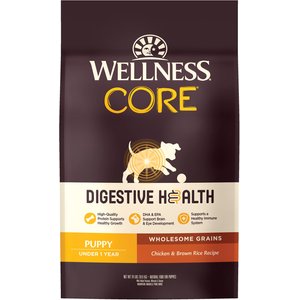
Although meaty, raw, and grain-free diets are popular picks for adult dogs, they may not sit well with young puppies, but Wellness CORE’s kibble quickly solves common digestive issues. Its nutritious base of chicken and nutritious grains like brown rice and oats are especially easy on a puppy’s stomach, resulting in firmer stool, and the supplementary probiotics support a stronger digestive system for their future. In addition to a healthier gut, we appreciate that this recipe is fortified with must-have vitamins and minerals for long-term eye, brain, skin, and coat development.
If your puppy has a sensitive tummy, this kibble is nutritious, especially easy to digest, and promotes overall wellness.

If you’re able to spoil your sweet little puppy with the best high-end food with no expense spared, The Honest Kitchen’s human-grade and veterinary nutritionist-designed dry kibble is your best option. Since each cluster is made from a mix of protein-rich cage-free chicken and nutritious ingredients like carrots, pumpkin, and apples, it’s not just exceptionally healthy, it is a meal that even the pickiest puppies will go wild for.
If money is no object, the premium cage-free chicken and other human-grade ingredients are worth every penny for an especially healthy and tasty diet.
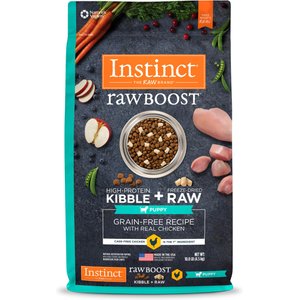
In our testing phase, puppies absolutely went wild for Instinct Raw Boost’s chunky raw pieces of cage-free chicken, which is excellent because they are loaded with vitamins, minerals and protein for healthy skin, coat and brain development. It is always adorable to see puppies loving the taste, but their human parents will appreciate this raw kibble’s grain-free formula, digestion promoting probiotics and nutrition list of premium ingredients formed into every bite. Good to know: Instinct Raw Boost has made our lists for the best dog foods for allergies, best dry dog foods, and best dog food brands.
Your dog will happily run to the bowl to pick out the raw pieces first, and that’s great since they contain more health benefits than the average piece of kibble.

As adorable as your best friend is, fussy eaters are less cute at dinnertime. Even though it may be tempting to stir something unhealthy into their food just to encourage them to eat sometimes, a pouch of Instinct Raw is a practically surefire way to get them to chow down without compromising on nutrition. I like this topper for its high protein, grain-free recipe, and how its savory broth-soaked meat chunks will convince even the pickiest of puppies to lick the bowl clean without a second thought.
With four meaty flavors to choose from, this savory grain-free topper is hands-down the best way to convince a particularly picky puppy to eat.

Since lesser dog foods are made with empty fillers like corn and wheat in their puppy foods, and many puppy owners are actively trying their best to avoid common food allergens, it is a relief to find a high-quality puppy food formulated with just a handful of main ingredients. Natural Balance’s Limited Ingredient Puppy recipe is mostly high-protein duck meat, potatoes, sweet potatoes, and a blend of vitamins and minerals, making it the best pick for puppies who need more nutrition from fewer ingredients.
If your puppy is suffering from allergy or digestive issues, this high-end, duck-based kibble is a healthy and effective diet.
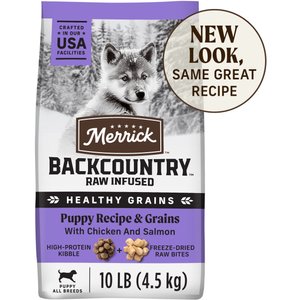
While raw diets are packed with an abundance of nutrition, raw meals without grain can be too difficult for some puppies to digest. In addition to puppies absolutely loving the taste, Merrick’s tummy-friendly freeze-dried recipe is a must-try for an early raw diet due to its perfect balance of protein-packed raw pieces of chicken and salmon and its blend of oatmeal and barley to promote a healthy digestive system from a young age.
This kibble includes the especially nutritious freeze-dried chunks puppies love, but it’s also a top-tier option for its high-protein, easy to digest formula.

Many pet parents prefer to go the extra mile to provide meals that only use human-grade ingredients. With its USDA certified organic fruits and vegetables, cage-free chicken, and wild-caught salmon, there’s a lot to appreciate about this meaty raw diet. Primal Freeze-Dried Raw’s high-protein recipe is grain-free, optimized for skin, coat, and digestive health, and takes seconds to hydrate and serve, making it as nourishing as it is convenient.
Perfect for puppies who turn their noses up at lesser diets, this impressive human-grade food is an especially nutritious and tasty meal for growing dogs.
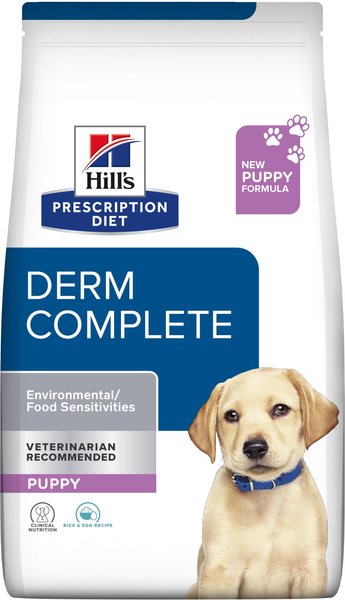
Trying to find a suitable food for your allergy-prone puppy can be extremely stressful, especially while they’re suffering from itchy skin and fur loss. But if your veterinarian writes your puppy a prescription for Diet Derm Complete, you and your puppy will easily sidestep the most common food allergens with the best dog food for allergies money can buy. This recipe utilizes rice and egg as its main ingredients, which makes it especially digestible yet nourishing. It doesn’t include any meat but your hungry puppy will appreciate the added chicken flavor. This one-of-a-kind kibble can also benefit pups with environmental allergies because it contains ingredients that reduce itching.
Whether your dog has trouble with food allergens or environmental ones, this is one of the best dog foods for allergies made specifically for puppies.
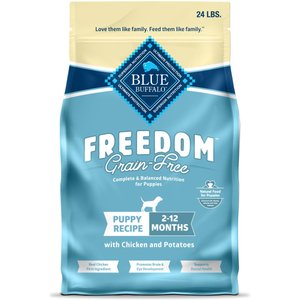
Although growing puppies may benefit from grains like oatmeal and barley in their diet due to the additional fiber, some dogs have an allergic reaction to grains. With its high-protein formula and exclusive, nutrition-packed LifeSource Bits™, this chicken-based Blue Buffalo kibble is a healthy way to nourish a puppy who cannot handle corn, wheat, and other grains.
If your puppy needs a grain-free diet, this quality protein-rich and healthy kibble formula is made without the corn, soy, and fillers that make their way into lesser dog foods.
A puppy’s nutritional needs are far different than their adult counterparts, as a puppy’s diet should include more fat, protein, and a specific range of other vitamins and minerals to support a healthy growing body. Always look for dog food brands specifically formulated for puppies above all else.
It’s a good idea to read the ingredient list but keep in mind that ingredients are listed by weight. That means a food with meat meal as the first ingredient can actually have more meat in it than one where the first ingredient is fresh beef, chicken, or lamb. That’s because fresh meat contains a high percentage of water whereas meat meal does not. But seeing premium ingredients in the first three or four ingredients is often a good sign that you are looking at a quality option.
Dr. Michael Greenberg, a practicing veterinarian in New Orleans and co-founder of The Veterinary Care Accessibility Project, adds that you should make sure that any food you are feeding your puppy is labeled as complete and balanced for puppies according to the requirements of the Association of American Feed Control Officials (AAFCO). However, not all puppy foods are labeled for large breed puppies, so if you have a large breed pup, read the fine print on the package to make sure it specifically states the food meets the requirements for the growth of large size dogs who will be 70 pounds or larger as an adult.
A golden retriever puppy and a pug puppy are completely different breeds, each with unique dietary needs. This ranges from the obvious need for tiny puppies to easily chew little kibble pieces instead of huge chunks, to the specific, narrower range of calcium needed for big puppies to develop strong bones and joints as they grow up. Giving large pups too much or too little calcium can cause bone deformities.
There is no all-around best puppy food. Some dogs may experience food allergies when exposed to certain ingredients, while others may have difficulty digesting specific formulas.
Although finding a specialized diet for your puppy may feel daunting, rest assured that with so many brands and recipes on the market, it’s easier than you’d think to put your puppy on the best diet possible. Talking with your veterinarian about diet is also a great idea.
Although your puppy’s preferences aren’t the most important consideration, a picky puppy may refuse to eat unless you provide them with something they prefer. As long as the food suits their dietary needs, feel free to try a few different protein sources until you learn which makes your puppy excited for dinnertime.
As you’re trying different foods, Dr. Greenburg says, “The transition to a new food should be gradual. Start by mixing a small amount (about 25%) of the new food with your puppy's current food (75%). Over the course of about a week, gradually increase the proportion of the new food while decreasing the old food. Monitor your puppy for any signs of digestive upset, such as diarrhea or vomiting.”
If you’re having a tough time convincing a puppy to eat, keep in mind that there are many healthy food toppers available. Whether you place a few wet, meaty pieces on top or stir the topper into their meal, a healthy dog food topper may be the best way to encourage a choosey puppy to chow down.
Between researching countless dog food recipes from both well-known and niche brands, having our own adorable puppies sample the most promising options, and prior experience with buying premium puppy food, I hand-picked the best dog food for puppies available today.
A few of the most important aspects we considered throughout our research included ingredient quality, formulas nutritionally balanced for puppies, the ability to purchase multiple sizes and flavors, and how appetizing the food was for the taste-testing puppies.
Both wet and dry puppy food have perks and negatives, and neither is inherently better or worse than the other. It’s up to you and your veterinarian to consider which is the best option for you and your puppy:
Wet food makes it easier to keep your puppy hydrated, is often more delectable than dry food—especially for picky eaters—and the extra water content in wet food helps puppies to feel full more quickly, which is great for weight control and preventing overeating.
On the other hand, dry food is generally more affordable, actively scrubs plague and tartar from a puppy’s teeth as they chew, and kibble lasts considerably longer when opened as opposed to wet food.
If you can’t decide between the two, you can mix dry and wet food. “This combination can be a good balance for nutrition and hydration,” says Dr. Greenberg. Plus, mixing can also add variety to your puppy's diet.
Preferences for dog food vary by veterinarian. For example, some prefer to avoid foods with any by-products, while others explain that they have nutritional value. Whatever you serve your pup, the ingredient list for it should be clear and easy to understand. If you're unsure about an ingredient, research it or consult your veterinarian, recommends Greenberg.
Avoid diets where fillers such as wheat and corn are the first ingredient. It’s also a good idea to steer clear of foods with artificial flavors and colors. Although quality dog foods can be high-priced, they are an excellent investment for your puppy’s long-term health.
That varies from puppy to puppy based on their body weight, the breed, and the food they eat. In addition to reading the product label for the food your pet is eating, it’s also ideal to consult with your veterinarian to determine the best dietary plan for your little dog.
Generally, weaned puppies under 12 weeks should be fed four times a day, while those between three and six months old should be fed three times a day, and after the six-month mark, a growing puppy needs two meals a day.
However you feed your puppy, it is a good rule of thumb to pick up any wet food they do not eat after 10 minutes to keep leftovers from spoiling or attracting bugs to their food bowl.
There is no all-time healthiest food for your puppy, and because every dog is unique, there is only the best food for each one’s specific nutritional needs. Some of the most important considerations to keep in mind when selecting the right meal for your best friend include finding a recipe that lists a high-quality animal protein as the first ingredient, such as chicken, beef, fish, or pork. Ignore options that utilize unnecessary ingredients and potential allergens like corn, soy, wheat, artificial flavors and artificial colors.
Pick foods that are complete and balanced, meet the nutritional levels established by AAFCO, and are appropriate for your pup’s breed. (It’s also the same advice for finding the best senior dog food.) Not all puppy food has a nutritional profile that’s appropriate for large breed puppies. In addition to researching which formulas contain the nutritional balance of protein, fat, fiber, vitamins, minerals, and antioxidants for your growing puppy’s ongoing health, talk with your veterinarian.
If your puppy shows an intolerance or allergic reaction to a food, talk with your veterinarian about doing a diet trial, such as with a limited ingredient diet. This can help confirm which ingredients are indeed problematic for your pup while pivoting to a safe alternate option.
The information presented here is created by TIME Stamped and overseen by TIME editorial staff. To learn more, see our About Us page.



